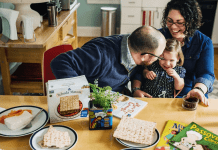My husband and I have walked into my late mother-in-law’s house for the last time.
We are in the process of settling her estate, including the sale of her house and disposition of everything in it.
From a hutch filled with china and crystal goblets to overflowing jewelry boxes and coin collections. And everything in between.
A lot in between.
Her clothes. The Notre Dame sweaters my late father-in-law was so fond of wearing. Her furniture. Furniture inherited from her mother-in-law, still in the same place in the garage where it was originally placed 30 some-odd years ago. My husband’s Cub Scout uniform. Christmas decorations. Lots and lots of Christmas decorations.
Every room, every closet, every shelf, every drawer. Full of stuff. A lifetime of stuff. Two lifetimes, if you count my father-in-law, who passed away 11 years ago.
What to Do With a Lifetime of Stuff
My mother-in-law was a neat and tidy housekeeper. But like many of us (myself included), she lived in a good-sized house with plenty of room to accommodate stuff. Things inherited from her parents and her in-laws. The broken vacuum cleaner waiting for repair in the back of the closet. Hundreds of books read once. You get the picture.
And the cost of disposing of all of that stuff? Having the estate sale company we hired go through every room, every closet, every drawer, separating the trash from the treasures, may cost more than will be generated at the eventual estate sale.
Her house has been transformed into a store, the estate sale company having cleverly arranged and displayed my mother-in-law’s possessions on tables in every room.
All of her possessions with any value, save the very few we kept, each with a tiny white price tag.
Losing your last surviving parent is hard enough. But being the arbiter of which of your parents’ and grandparents’ treasures get saved and which end up sold, donated, or in a landfill? gut-wrenching.
The lesson we have learned from this experience?
Most of the stuff in your house is worthless. And eventually, someone, either you or your kids, will be tasked with the overwhelming job of getting rid of it.
Most of Your Stuff Is Worthless
Most of the stuff in your house is worthless.
Yes, even the stuff you worry the most about, the stuff you think is so good you don’t use it for fear of breaking it, has little to no resale value.
From china, china cabinets, crystal goblets, silver tea sets, pianos, and collectible figurines like Hummels, to grandfather clocks and real pieces of craftsmanship furniture.
Why? Baby boomers have glutted the market with their castoffs, and millennials, the next generation of buyers, don’t want it.
Millennials hate both formal in-home entertaining and use of second-hand goods. With looming student loans, they tend to rent and move often. Who wants to be constantly moving a piano and a grandfather clock from apartment to apartment?
And furniture? There’s no market for so-called “brown furniture,” meaning any furniture (regardless of quality) other than the “mid-century casual” furniture (think clean, lightweight) favored by millennials. Brown furniture is basically firewood.
If it’s not in great condition, it’s also not fit for donation because it can’t be resold.
All of my mother-in-law’s furniture (including the pieces inherited from her mother-in-law and kept for decades)? Straight to the landfill.
Well, Almost Everything…
What do guns, LPs (records), and precious metals/gems have in common?
They are 3 things you might have in your house with a robust resale value.
Silverware also has value, but only if it is real silver and can be melted down.
3 Things You Should Be Doing NOW to Reduce the Amount of Stuff You Have
1. Be viciously thoughtful about holding onto sentimental items.
Here was our goal with sorting through my mother-in-law’s things. Keep just enough to remind us of her, but not so much stuff that our daughters are going to be dealing with it 40 some-odd years from now.
Here’s what we kept:
- A painting to be displayed in our dining room
- My mother-in-law’s treasured Swarovski crystal animal collection (all of which were given to her by her children and grandchildren over the years)
- Jewelry to be divided among the granddaughters
- Each of our daughters got to select 1 item
And that was it.
Well, almost. We did set aside photos to be digitized (with the originals then destroyed).
Was it hard leaving everything else? You bet it was. But we don’t want to be dealing with a lot of stuff years from now (or worse, leaving it to our daughters to deal with).
I try to be viciously thoughtful with my own sentimental items. For example, I don’t save any school papers or art projects from my kids (though I do take photos of my favorites).
2. Buy fewer books.
While used book resellers like Half Price Books do an important service in keeping books in circulation, a surprising number of books end up in landfills because many paper recycling facilities can’t process the the glue that binds book spines.
My resolution last year was to cut down on my book consumption by only reading books that I borrow from the library or purchase on my Kindle e-reader. If you haven’t used a library in years, now is the time to go back. My local library has an app where you can “order” books online, and pick them up the next day on a special “hold” shelf strategically placed next to the check-out kiosk.
How successful was I on my resolution? I read 1 to 2 books a week in 2019, only 1 of which was a hard copy purchased from Amazon.
3. Buy fewer, but better quality, clothes
The world is overflowing with used clothing.
We buy substantially more clothing over our lifetimes than our grandparents did.
Clothing made today is meant to last no more than a few years. In fact, a lot of clothing isn’t even made to withstand more than a few washes.
Think you are “paying it forward” but dropping off a load of unwanted clothes at Goodwill? Think again. Most clothing donations never make it to the racks at Goodwill and only about a third of what does eventually sells.
To really pay it forward, cut down on the amount of clothing you have by buying better quality clothes that last longer.
Keeping What Really Matters
My 5-year-old chose to keep a Christmas music box from her Grandma’s house. It plays “White Christmas” and has tiny ice skaters going around a rink inside. Each Christmas, my mother-in-law would bring out this music box and let each of her granddaughter’s play with it. It’s value in preserving a precious memory of Grandma? Priceless.














If the only thing you had to do when your parent or in-law died was to get rid of their “stuff”, pity you. Did you also have to house them in their later years? Feed them? Change their diapers? Lovingly tend to their physical and emotional needs? Stuff is the easy part!
Great article!
I thought this would be a positive article at first. I wholeheartedly disagree with most of what the author says. Especially “brown furniture “. Are you kidding me? Furniture nowadays is NO WHERE near the quality of the old. The stuff sold in stores today is plasticky, smells, breaks easily and looks cheap. I realize you can’t keep everything, so keep what is memorable to you and your family, and donate the rest. There are many needy people out there and they would be grateful for your cast offs. One man’s trash is another man’s treasure.
From a septuagenarian. Ever watched Antique Roadshow? Notice how values of articles fluctuate with the times. This rejection of of china, wood furniture, things, will change. But it seems the younger authors writing with such authority today fail to recognize that. My advice – If you love the things you live with, keep them. Enjoy them. It’s your choice. You can clean out, downsize without being brutal.
And really. To the author. Why use such an insulting term to say a reader’s “stuff is worthless”?
I am one of those baby boomers with a beautiful home full of treasures andI do not want to put my children through what you went through! However, between babysitting for the grandchildren, and just living our lives there is very little time or energy to sift through our treasures. But more to the point I would love for my children to take an interest NOW while I’m healthy to spend time with me and go through things while making new memories for them to look back on when I am gone!
Also as many other people have commented, I belong to a community service group and there are many people out there that can use whatever my children do not want. The landfill should not be a choice until you have exhausted of other choices! There are many homeless in our country and very poor people that can use any number of things coming from our homes!
I have lost both my parents and only wish that I had taken more time while they were here to go through their things and get more stories to help go along with their “treasures”.
I agree with this stuff does sell is this. People may think me selfish but I really don’t care about the difficulty my heirs have moving it. Most of those “worthless” items you grouse about miving out has value to me. A remembrance of people or events from the past that I will always treasure. Be happy you’re inheriting my stuff and my place. If it is such a chore just sell everything, including my house, as is. If it’s really a bother donate the entire structure to someone or some organization it will help.
Do not destroy original photos! Dumbest thing I have ever read. Digital files can be lost. Computers are replaced every 5-10 years. No descendant is going to spend time looking at every CD you own. Will people even be using CDs in 50 years? Digital files that just sit in your home are not a reliable way to save history. Yes f you upload them to the Internet to places like Ancestry & FamilySearch & Findagrave then yes, they might have a chance of living on. But the author of this article doesn’t suggest that. I’ve had multiple cousins tell me they scanned their old photos years ago & can’t find the files.
I like everything you said except for destroying the originals of photos after they’re digitized. I think that would be a huge mistake. However they’re stored digitally, they’re not guaranteed to still work in the future. Some people digitize their VHS tapes onto DVDs and if they get scratched badly enough, that’s it. A USB thumb drive? It may physically get damaged or may not be readable in 20 years. Digital files can also get damaged, corrupted. Computers crash and sometimes files are irretrievable. I wouldn’t get rid of the originals. Get them digitized, yes, but don’t take the risk of something going wrong and never having those originals.
Never ever destroy an original photo, unless you have very large quality scans! If your file is gone then they are gone forever. Many are one of a kind. That’s my opinion!
there are plenty of places beside Goodwill to donate clothing. I send mine to a gentleman who helps the poor and the homeless, I am sure there are people like that in her area